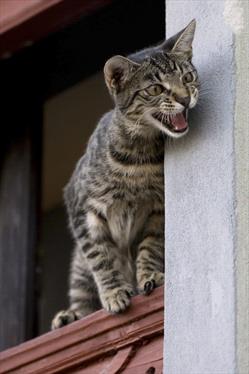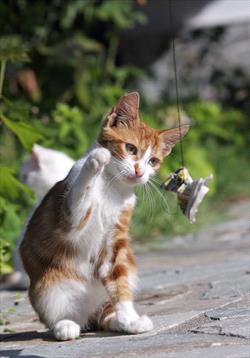It’s three hours past dawn and the songbirds are strangely silent. The house is still, devoid of life save a lone Tabby sitting bold, solitary, and aloof in the window with a beam of sunshine spotlighting his silver and stripes. He is the keeper of his house, the king of his territory. Then he turns, looks. And then Weeoow! Weeeoooww! His wails grate the air like freshly manicured nails sliding down a squeaky clean chalkboard.
Why the mournful meowing?
This kitty wants his mommy and she’s just left for work.
Tabby drops down from his pedestal and paces five steps to his left. Weeeooow! Five paces to the right. Weeooow! Five paces to the left again. Weeoow! Weeooow!
Then, he’s off to the bed that he shares with his favorite human. He stays just long enough to lay a smelly surprise and then heads back to pace by his special window spot.
He’s spiteful, vengeful, vindictive, some might say. But if so, they’d be wrong. This pouting pussy cat suffers from what Dr. Stefanie Schwartz, a board certified veterinary behaviorist, dubs separation anxiety syndrome (SAS).
According to Schwartz, who described this syndrome for the first time in cats in the Journal of the American Veterinary Medical Association in 2003, separation anxiety syndrome is an emotional response that triggers misbehavior when separated from an attachment figure. Well, technically it’s not misbehavior according to the cat. But these cats engage in all types of normal cat behaviors, just at inappropriate times or locations by human standards.
Unlike the separation anxiety in humans, which is a mild to moderate affective disorder characterized by mild weeping and social withdrawal, the anxiety in SAS pets ranges in intensity from the mild but heart-breaking stress often seen on a child’s first day at school to an all-out episode reminiscent of a panic attack in human adults. The most extreme form is more obvious in dogs who, “faster than a speeding bullet”, have been known to hurl themselves out of two story windows and, “with more power than an Amtrak locomotive,” have chewed through doors and walls, often injuring themselves in the process.
Anxious cats usually don’t perform acts that are so swiftly devastating to your property or to themselves. They most frequently express their angst by leaving poo presents or urine spray surprises in random areas in the house (or less random areas such as your bed or your clothes). They may also wail with the energy and endurance of the Energizer Bunny or use their shear-like claws to shred your favorite furniture.
They can’t help themselves. When their special companion is gone, they may think it’s forever. This sends their heart racing and their stress hormones off the scale. It can even initiate stomach and intestinal upset, thus the pooping out of place. To alleviate their anxiety, they start to label their “stuff”, with their claws and pungent urine spray.
Anxious cats may even possibly damage themselves by grooming excessively. Not the vain reality TV model-type hair-stroking meant to enhance appearance so as to attract the opposite sex. More like pulling hair out in patches that can span entire thigh or belly or back.
Not all cats that make a sudden commode change or that rough up your favorite furniture have SAS though. Says Schwartz, The main thing is that the misbehavior occurs in the owner’s absence. Sometimes it just starts in the owner’s absence though. For instance Schwartz states, a cat that begins to urinate on the owner’s bed when left alone may have separation anxiety syndrome but could continue to urinate on the bed even when the owner is home because the behavior is maintained by other things, such as environmental cues.
The diagnosis gets even more complicated when you consider other cases of similar signs such as urinary tract infections or intestinal disorders leading to lapses in litter box use and allergies, hormonal disorders, and mite or flea infestations leading to hair loss. Thus, a visit or two to your veterinarian should be first on your list when you see suspicious signs in your cat.
How to Help A Cat Who Mourns Your Absence?
What should you do if you think your cat has SAS? It’s all about quality time when the owners are home so that he is tired and satisfied to rest comfortably by the time the owner leaves, explains Schwartz. “That means scheduling in multiple play sessions or teaching some favorite kitty tricks.”
It also means creating an environment that’s fun and enriching when you’re gone. Such as by putting Tabby’s food in a food dispensing toy when you leave, hiding treats in various locations around the house, placing perches in locations where Tabby can view what’s going on outside—even placing a bird feeder outside the window. Some cats, more commonly those who have been well socialized when young, even enjoy having other pet playmates.
Most importantly, if you come home and find an “accident” on your antique bed, don’t get angry. It just means your kitty loves you.
First appeared in the SF Chronicle in 2002




